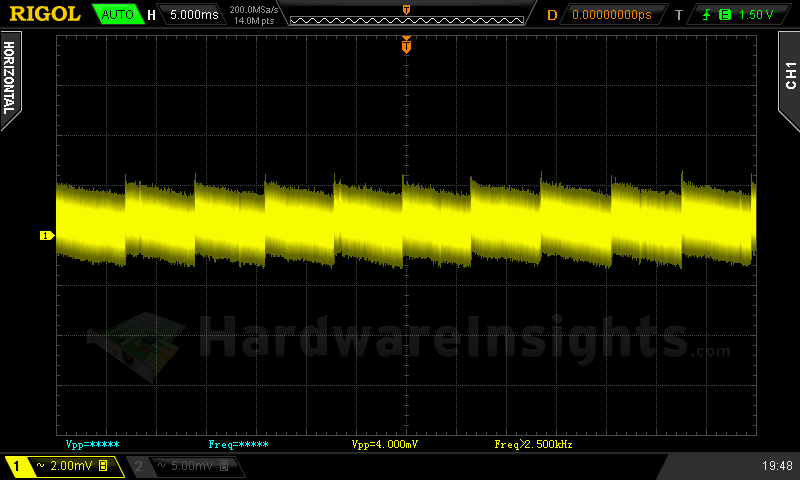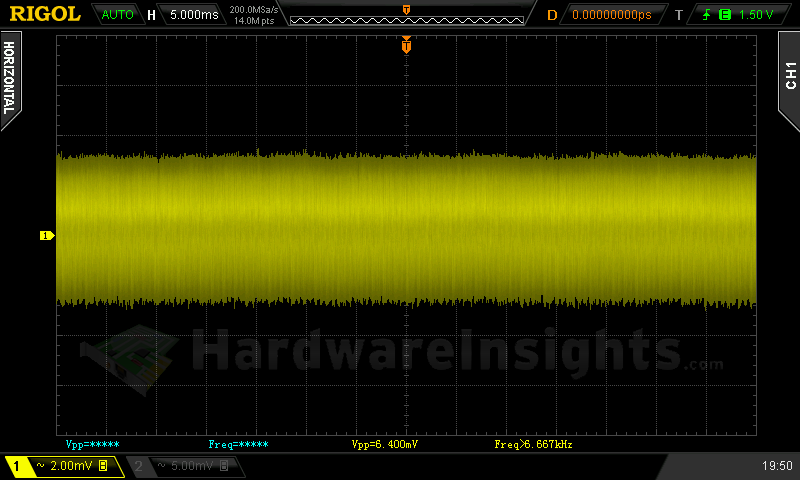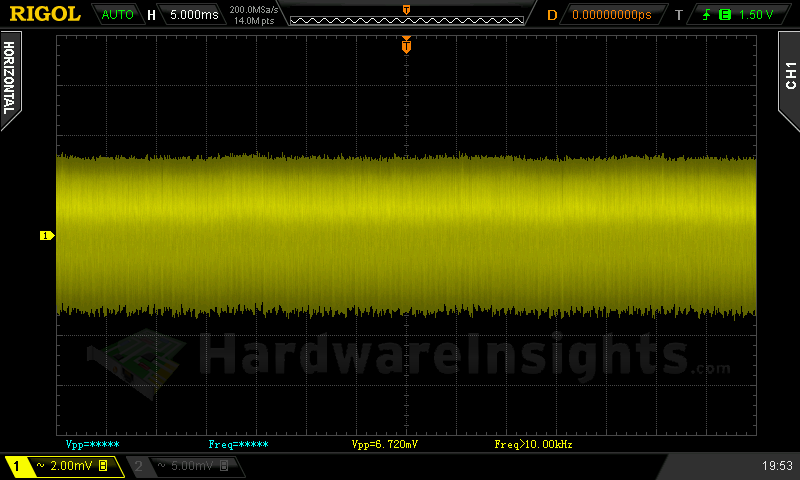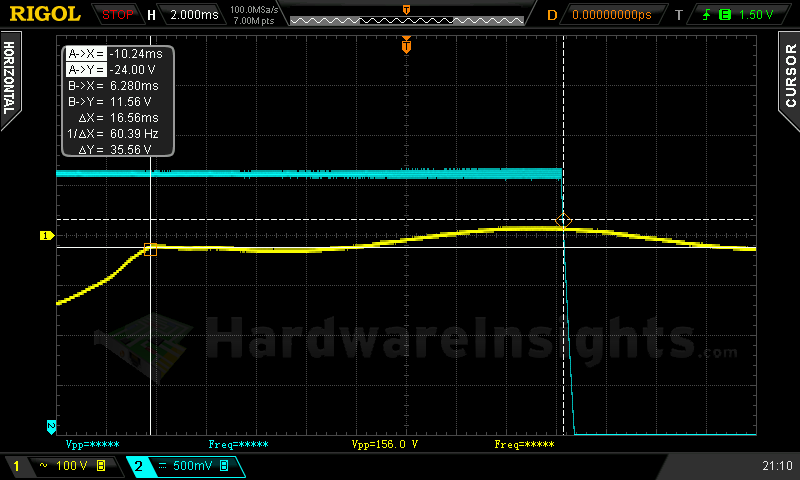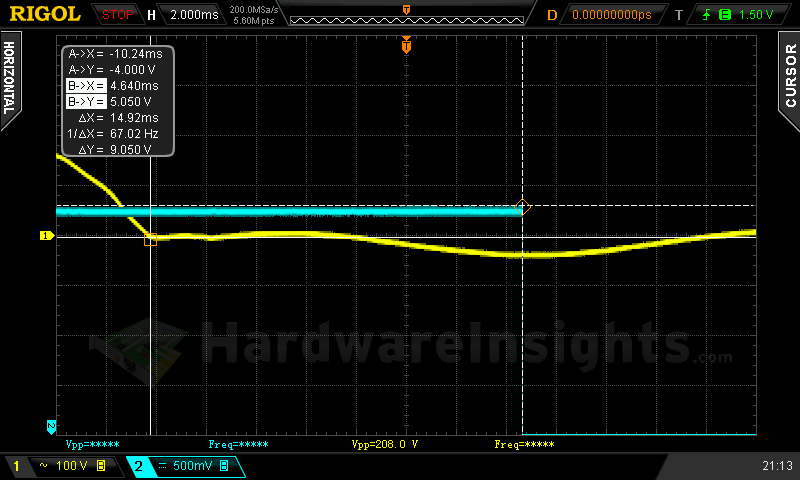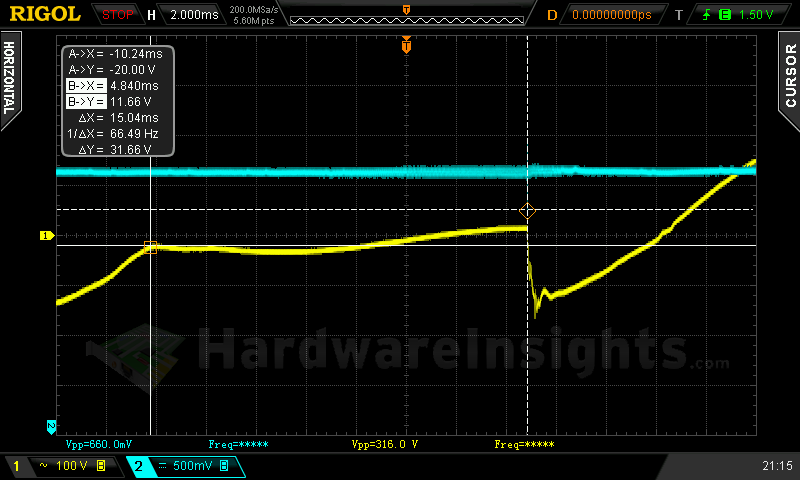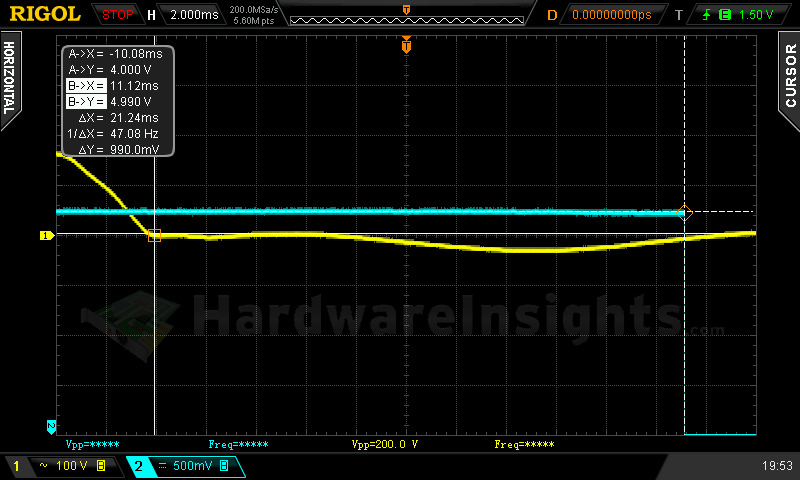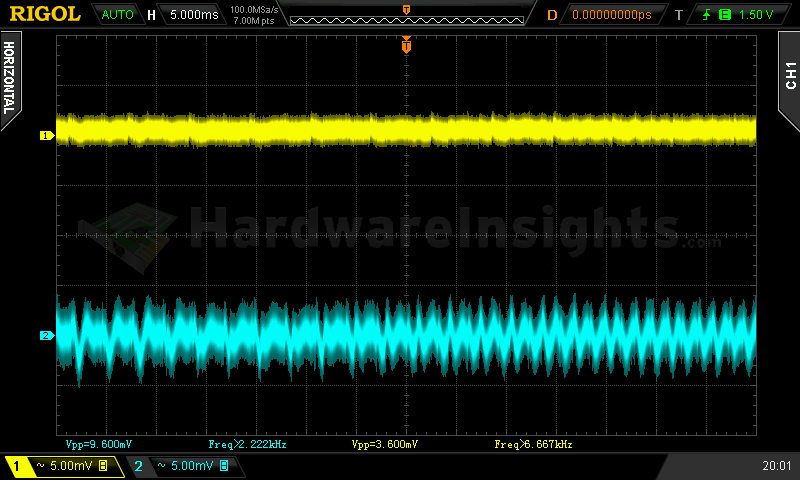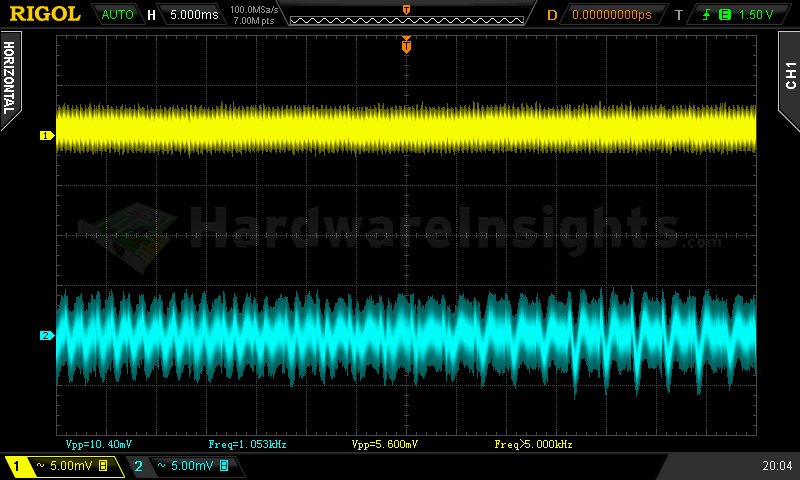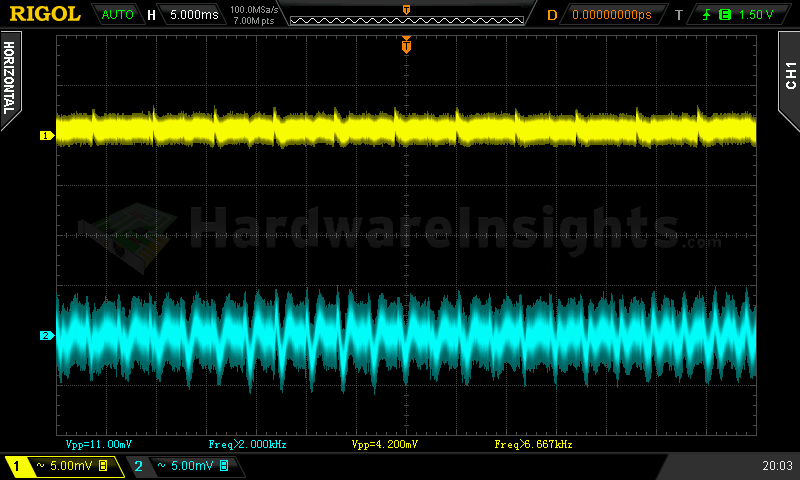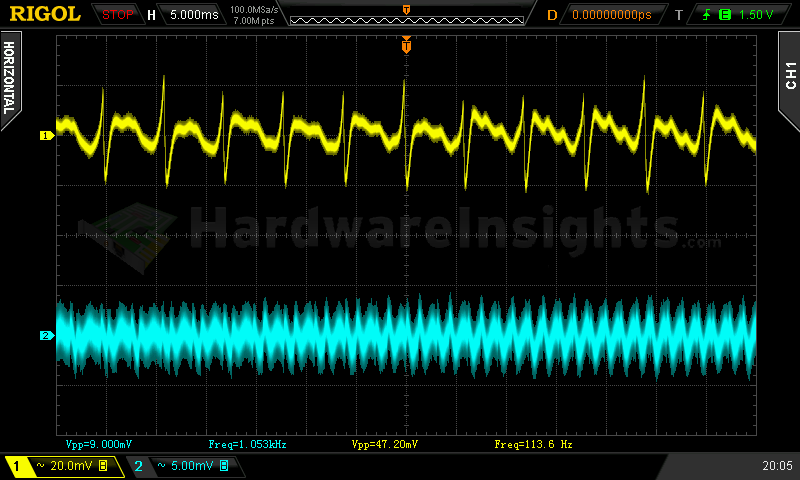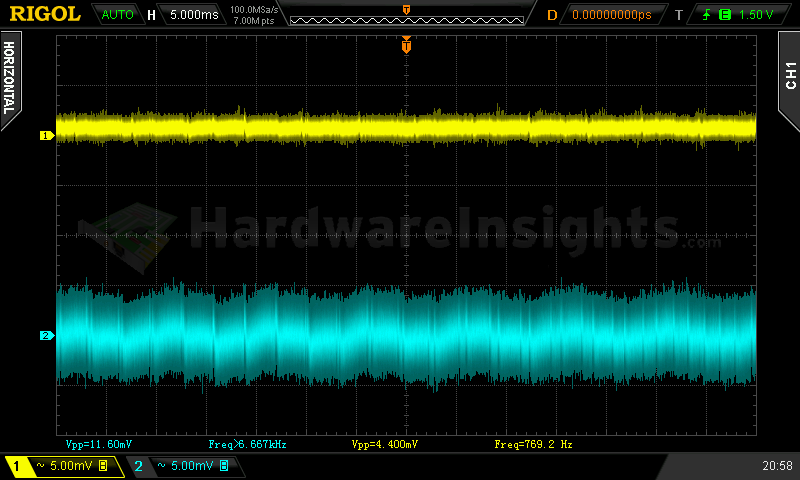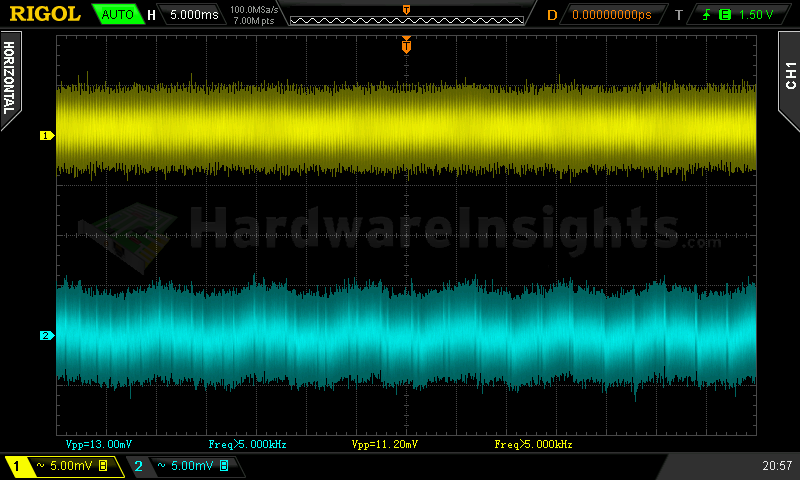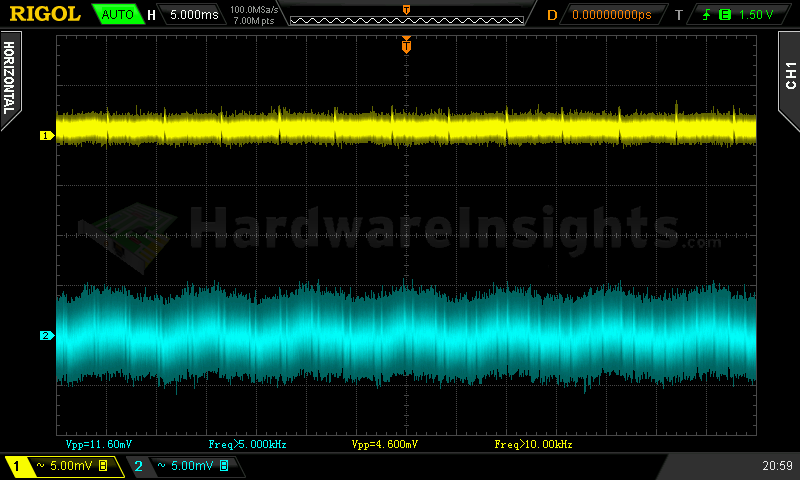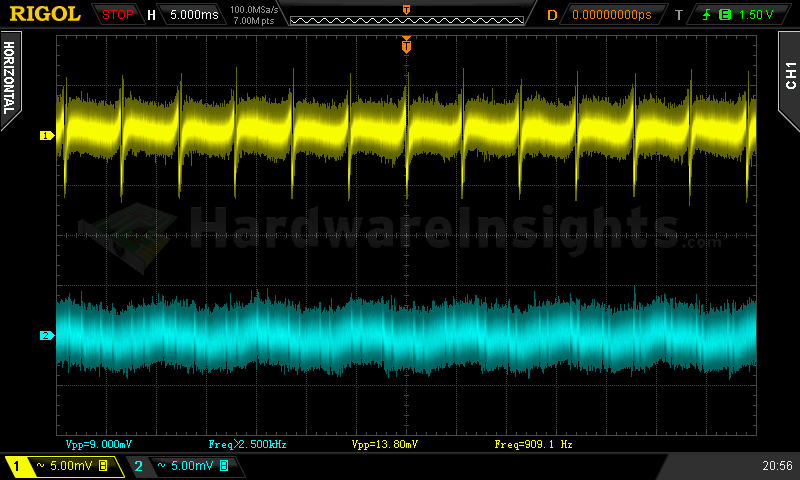Contents
- 1Introducing the Cooler Master V650
- 1.1Packaging and accessories
- 2Connectors & cabling
- 2.1Casing & cooling
- 3Input filtering
- 4Primary side
- 4.1+5 V stand-by rail
- 5Secondary side
- 5.1Build quality
- 6Load testing
- 6.1Loading +5 V SB
- 6.2Hold-up time
- 6.3Combined loading
- 6.4Combined loading ripple
- 6.5Crossloading, overloading
- 6.6Crossloading, overloading ripple
- 6.7Fan speed, temperatures and noise
- 7Conclusion and evaluation
- 7.1Thanks
- 7.2Discussion
Load testing
Loading +5 V SB
As always, all load testing is performed per our testing methodology. The voltage regulation is on the lower side, as we are accustomed to with Enhance. Ripple is OK and efficiency is just about average.
| Output (W) | Load (A) | Voltage (V)/ ripple (mV) | Input (W) | Efficiency/power factor |
| 0 | 0 | 4.919/4.000 | 0 | —/0.001 |
| 11.39 | 2.348 | 4.849/6.400 | 14.79 | 77.0 %/0.321 |
| 15.71 | 3.26 | 4.818/6.720 | 20.82 | 75.4 %/0.399 |
+5 V SB ripple (left to right): 0 A; 2.348 A; 3.26 A
Hold-up time
As we can see on the oscilloscope screenshot, the hold-up time of the VS650 +12 V rail is not even in spec at 16.56 ms. Not that it’s that much over the 16 ms Cooler Master specified on the box.
The hold-up time of the power good signal is shorter as it should be according to the ATX specification. But it is only 14.92 ms. Note that many competing units are even worse, but that still does not mean that this is fully in spec.
While interrupting the power for a given time, I found the +12V rail hardly noticed it. Well there is a very brief drop but that’s negligible. At least this single rail thing is OK. But still, the unit is going to loose some points here. Enhance should have had used a 560μF primary input capacitor in this unit, 470 does not cut it.
Replacing the input capacitor with Chemi-Con KMZ 680/420 resulted in extension of the PG hold-up time all the way to 21.24 ms. That is over 40 % or 6 ms more so chances are with 560μF capacitor it would pass just fine not only on the ATX spec, but also on my high-end requirements.
Combined loading
Combined loading was quite good. Lets talk about the voltage regulation first. The Cooler Master V650 does not break the habit of other Enhance units -12V regulator not regulating under higher output. At least until the power output of the unit is high enough so the regulator input voltage decreases low enough it finally goes into regulation stage. Overall, the voltages stay within 2% from nominal. They are set to be slightly over under no load and slowly fall under nominal under full load. The line regulation is still not that great though, slightly over 2 %. It’s not bad either, but one would expect better from a unit which has the voltage sensing feedback on all the three main rails plus a return…and not to mention for its higher price.
| Output power | Load/ voltage +5 V SB | Load/ voltage +3.3 V | Load/ voltage +5 V | Load/ voltage +12 V | Load/ voltage −12 V | Input power | Efficiency/ power factor |
| 4.2 %/ 27.25 W | 0 A/ 5.010 V | 0 A/ 3.321 V | 0.297 A/ 5.008 V | 1.839 A/ 12.194 V | 0.292 A/−11.439 V | 38.28 W | 71.2 %/ 0.597 |
| 20 %/ 132.06 W | 0.533 A/ 4.988 V | 1.444 A/ 3.308 V | 1.458 A/ 4.996 V | 9.36 A/ 12.166 V | 0.294 A/ −11.776 V | 152.4 W | 86.7 %/ 0.906 |
| 40 %/ 256.48 W | 1.026 A/ 4.976 V | 2.78 A/ 3.294 V | 3.27 A/ 4.982 V | 18.27 A/ 12.166 V | 0.310 A/ −11.781 V | 286.8 W | 89.4 %/ 0.946 |
| 60 %/ 385.64 W | 1.510 A/ 4.957 V | 3.98 A/ 3.280 V | 4.73 A/ 4.968 V | 27.9 A/ 12.111 V | 0.310 A/ 11.962 V | 431.7 W | 89.3 %/ 0.960 |
| 80 %/ 527.50 W | 1.89 A/ 4.934 V | 5.31 A/ 3.264 V | 5.86 A/ 4.949 V | 38.8 A/ 12.038 V | 0.301 A/ −11.979 V | 597.6 W | 88.3 %/ 0.969 |
| 100 %/ 647.45 W | 2.37 A/ 4.905 V | 7.15 A/ 3.249 V | 6.53 A/ 4.930 V | 47.9 A/ 12.034 V | 0.331 A/ −11.991 V | 736.6 W | 87.9 %/ 0.971 |
As for the efficiency, as usual, please take into consideration my efficiency measurement accuracy (or inaccuracy, lol), the unit seems to pass 80 PLUS Gold well enough. Low-load efficiency could be a bit better though.
Combined loading ripple
The ripple values are also outstanding, except for the -12V rail. As usual, before its regulator started doing something, the ripple created by the fan of my load tester wasn’t filtered out. Then it dropped to just slightly above 1/4 of the initial figure. Otherwise, the results are great, the +12 V rail was just slightly above 10 mV. Altogether, the positive rails managed to stay under 10 mV in 17 cases out of 24. I think I can still throw in a point for that.
| Output % | Ripple +5 V SB | Ripple +3.3 V | Ripple +5 V | Ripple +12 V | Ripple −12 V |
| 4.2 | 3.600 mV | 5.600 mV | 4.200 mV | 11.00 mV | 47.20 mV |
| 20 | 3.000 mV | 4.600 mV | 5.000 mV | 10.00 mV | 46.40 mV |
| 40 | 3.600 mV | 6.000 mV | 4.200 mV | 11.00 mV | 44.80 mV |
| 60 | 6.600 mV | 7.800 mV | 5.000 mV | 11.20 mV | 23.60 mV |
| 80 | 7.400 mV | 6.000 mV | 5.400 mV | 12.40 mV | 12.80 mV |
| 100 | 4.400 mV | 11.20 mV | 4.600 mV | 13.00 mV | 13.80 mV |
Ripple 4.2% load (left to right): +5 V SB; +3.3 V; +5 V; −12 V. The second channel is connected to +12 V.
Ripple 100% load (left to right): +5 V SB; +3.3 V; +5 V; −12 V. The second channel is connected to +12 V.
Crossloading, overloading
Crossloading tests went fine, as could be expected from such a platform with DC-DC modules. The voltage regulation was pretty much the same as under combined loading tests, for both line and load. The efficiency dropped a bit and remained at just around 80 %. As for the overloading of different rails, the unit did not react to the load that I could apply to it in this scenario.
| Output power | Load/ voltage +5 V SB | Load/ voltage +3.3 V | Load/ voltage +5 V | Load/ voltage +12 V | Load/ voltage −12 V | Input power | Efficiency/ power factor |
| 16 %/ 102.74 W | 0.534 A/ 4.976 V | 22.1 A/ 3.284 V | 0.292 A/ 4.992 V | 1.853 A/ 12.173 V | 0.298 A/ −11.722 V | 129.2 W | 79.5 %/ 0.884 |
| 21 %/ 135.89 W | 0.583 A/ 5.129 V | 0 A/ 3.297 V | 21.59 A/ 4.968 V | 1.831 A/ 12.173 V | 0.283 A/ −11.844 V | 167.7 W | 81.0 %/ 0.913 |
| 100 %/ 647.76 W | 0.540 A/ 4.946 V | 0 A/ 3.265 V | 0.335 A/ 4.962 V | 53.2 A/ 12.028 V | 0.295 A/ −11.981 V | 732.7 W | 88.4 %/ 0.971 |
| 155 %/ 1007.30 W | 3.30 A/ 4.954 V | 21.7 A/ 3.172 V | 27.7 A/ 4.816 V | 65.8 A/ 11.931 V | 0.303 A/ −12.063 V | 1223.0 W | 82.4 %/ 0.982 |
Overloading the V650 was a nightmare. I threw everything I had against it, and it was still left standing! At 1 kW! It did however overheat after a couple of minutes. So technically, I can not state for sure whether the OCP and OPP actually work. Everything should points to a conclusion that they in fact do, only the limit is just set much too high for me to personally find out for certain. The unit provided one kilowatt well within spec for a while until it overheated, so this is just fine by me as far as protections go. This is by far the highest overload any unit withstood so far so I will award 5 points for this!
Crossloading, overloading ripple
Here the ripple was similar to that of the combined loading set of tests. Though we now have 10 out of 12 measurements on positive rails where the unit managed to keep <10 mV. Another point for this!
| Output % | Ripple +5 V SB | Ripple +3.3 V | Ripple +5 V | Ripple +12 V | Ripple −12 V |
| 16 | 3.400 mV | 3.800 mV | 4.200 mV | 10.20 mV | 44.80 mV |
| 21 | 4.400 mV | 5.200 mV | 4.200 mV | 9.000 mV | 36.80 mV |
| 100 | 6.000 mV | 3.800 mV | 5.400 mV | 12.00 mV | 10.20 mV |
| 155 | — | — | ~13.00 mV | ~12.00 mV | — |
Fan speed, temperatures and noise
The fan inside the Cooler Master V650 started spinning right after the unit turned on. But until the test number five (80% load) it stayed at its minimum speed of approx. 560 RPM. At such a speed it was almost inaudible and even at around 950 RPM it was still only just slightly noticeable. The Corsair RM550x’s fan reaches a similar maximum fan speed yet we have 650W unit here. So the unit is capable of staying pretty much silent throughout all its normal range of loading. There is no reason why not to use the V650 even in very silent builds. It is not semi-fanless, but very quiet nevertheless, so I think granting one extra point here would be fair.
| Output % | Fan speed (RPM) | Temperature intake/ outtake | Noise (dBA) |
| 4.2 | 552 | 18 °C/ 21 °C | 39.2 |
| 20 | 555 | 19 °C/ 22 °C | 39.2 |
| 40 | 561 | 19°C/ 25 °C | 39.2 |
| 60 | 567 | 20 °C/ 29 °C | 39.2 |
| 80 | 662 | 22 °C/ 34 °C | 39.4 |
| 100 | 943 | 22 °C/ 39 °C | 39.4 |
| CL 16 | 603 | 21 °C/ 35 °C | 39.3 |
| CL 21 | 572 | 21 °C/ 35 °C | 39.2 |
| CL 100 | 913 | 21 °C/ 38 °C | 39.4 |
| OL 155 | 2292 | 22 °C/ 47 °C | 44.4 |
The temperatures were reasonable as well. Of course under maximum overload the unit’s fan was running at full speed, and by then it was already very noisy. It was also quite hot as it finally did manage to overheat. As for the overheating tests themselves, the unit took 12 minutes and 28 seconds to overheat which is a pretty good result. I’ll throw two more points in there for this.
